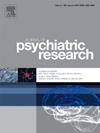Increased sleep duration and emotional regulation in patients with major depressive episodes
IF 3.7
2区 医学
Q1 PSYCHIATRY
引用次数: 0
Abstract
Introduction
Increased total sleep duration complaint is frequently associated with psychiatric disorders. The daytime impact of sleep disorders is directly linked to the management of emotions and behaviors. Complaints of increased total sleep duration in major depressive disorder (MDE) could be a factor in the disruption of emotional regulation, which belongs to specific, atypical and often more severe clinical pictures.
Methods
Our study compared aspects of emotional reactivity using the Multidimensional Assessment of Thymic States (MAThyS) according to self-declared complaint of increased total sleep duration among a cohort conducted within the ChronoS Center, assessing for sleep and psychiatric disorders.
Results
Twenty-one patients were included in the increased sleep duration (ISD) group and 126 patients in the normal or reduced sleep duration (NRSD) group. The frequency and severity of MDE was similar between the two groups, but atypical and seasonal features were more frequent in ISD group. ISD group also reported higher use of cannabis. Regarding emotional reactivity, MAThyS sub-scores in ISD group showing both decreased motivation and interpersonal communication skills compared to NRSD group (p = 0.03 and p = 0.02).
Conclusion
Hypersomnolence complaints with increased sleep duration could lead to decreased motivational and interpersonal communication capacities compared to normal or decreased sleep duration in MDE. Although these results present an interesting perspective for specific psychotherapy and pharmacological, and non-pharmacological treatments as light therapy, focused on wakefulness to enhance interpersonal communication skills and motivation.
重度抑郁发作患者睡眠时间延长和情绪调节能力增强
本文章由计算机程序翻译,如有差异,请以英文原文为准。
求助全文
约1分钟内获得全文
求助全文
来源期刊

Journal of psychiatric research
医学-精神病学
CiteScore
7.30
自引率
2.10%
发文量
622
审稿时长
130 days
期刊介绍:
Founded in 1961 to report on the latest work in psychiatry and cognate disciplines, the Journal of Psychiatric Research is dedicated to innovative and timely studies of four important areas of research:
(1) clinical studies of all disciplines relating to psychiatric illness, as well as normal human behaviour, including biochemical, physiological, genetic, environmental, social, psychological and epidemiological factors;
(2) basic studies pertaining to psychiatry in such fields as neuropsychopharmacology, neuroendocrinology, electrophysiology, genetics, experimental psychology and epidemiology;
(3) the growing application of clinical laboratory techniques in psychiatry, including imagery and spectroscopy of the brain, molecular biology and computer sciences;
 求助内容:
求助内容: 应助结果提醒方式:
应助结果提醒方式:


